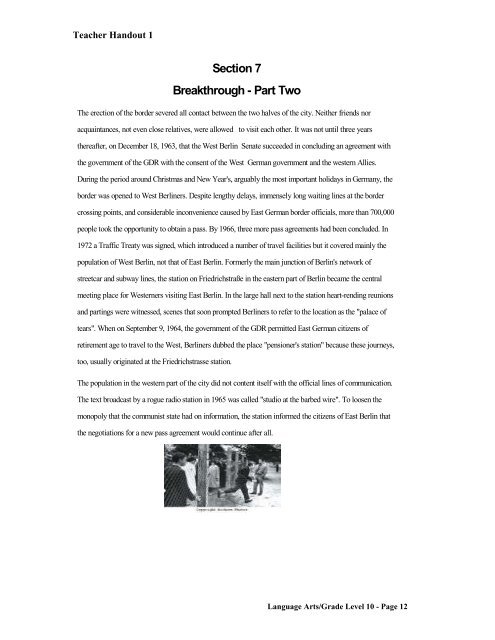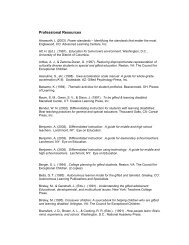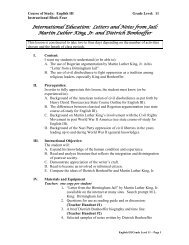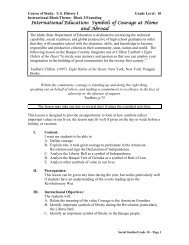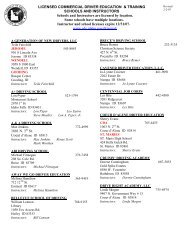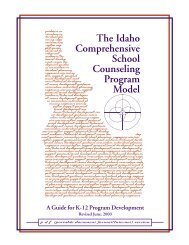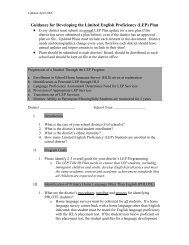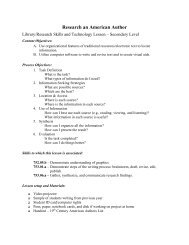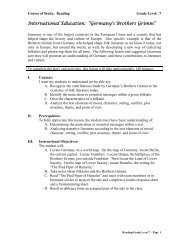International Education: Civil Disobedience at the Berlin Wall
International Education: Civil Disobedience at the Berlin Wall
International Education: Civil Disobedience at the Berlin Wall
You also want an ePaper? Increase the reach of your titles
YUMPU automatically turns print PDFs into web optimized ePapers that Google loves.
Teacher Handout 1<br />
Section 7<br />
Breakthrough - Part Two<br />
The erection of <strong>the</strong> border severed all contact between <strong>the</strong> two halves of <strong>the</strong> city. Nei<strong>the</strong>r friends nor<br />
acquaintances, not even close rel<strong>at</strong>ives, were allowed to visit each o<strong>the</strong>r. It was not until three years<br />
<strong>the</strong>reafter, on December 18, 1963, th<strong>at</strong> <strong>the</strong> West <strong>Berlin</strong> Sen<strong>at</strong>e succeeded in concluding an agreement with<br />
<strong>the</strong> government of <strong>the</strong> GDR with <strong>the</strong> consent of <strong>the</strong> West German government and <strong>the</strong> western Allies.<br />
During <strong>the</strong> period around Christmas and New Year's, arguably <strong>the</strong> most important holidays in Germany, <strong>the</strong><br />
border was opened to West <strong>Berlin</strong>ers. Despite lengthy delays, immensely long waiting lines <strong>at</strong> <strong>the</strong> border<br />
crossing points, and considerable inconvenience caused by East German border officials, more than 700,000<br />
people took <strong>the</strong> opportunity to obtain a pass. By 1966, three more pass agreements had been concluded. In<br />
1972 a Traffic Tre<strong>at</strong>y was signed, which introduced a number of travel facilities but it covered mainly <strong>the</strong><br />
popul<strong>at</strong>ion of West <strong>Berlin</strong>, not th<strong>at</strong> of East <strong>Berlin</strong>. Formerly <strong>the</strong> main junction of <strong>Berlin</strong>'s network of<br />
streetcar and subway lines, <strong>the</strong> st<strong>at</strong>ion on Friedrichstraße in <strong>the</strong> eastern part of <strong>Berlin</strong> became <strong>the</strong> central<br />
meeting place for Westerners visiting East <strong>Berlin</strong>. In <strong>the</strong> large hall next to <strong>the</strong> st<strong>at</strong>ion heart-rending reunions<br />
and partings were witnessed, scenes th<strong>at</strong> soon prompted <strong>Berlin</strong>ers to refer to <strong>the</strong> loc<strong>at</strong>ion as <strong>the</strong> "palace of<br />
tears". When on September 9, 1964, <strong>the</strong> government of <strong>the</strong> GDR permitted East German citizens of<br />
retirement age to travel to <strong>the</strong> West, <strong>Berlin</strong>ers dubbed <strong>the</strong> place "pensioner's st<strong>at</strong>ion" because <strong>the</strong>se journeys,<br />
too, usually origin<strong>at</strong>ed <strong>at</strong> <strong>the</strong> Friedrichstrasse st<strong>at</strong>ion.<br />
The popul<strong>at</strong>ion in <strong>the</strong> western part of <strong>the</strong> city did not content itself with <strong>the</strong> official lines of communic<strong>at</strong>ion.<br />
The text broadcast by a rogue radio st<strong>at</strong>ion in 1965 was called "studio <strong>at</strong> <strong>the</strong> barbed wire". To loosen <strong>the</strong><br />
monopoly th<strong>at</strong> <strong>the</strong> communist st<strong>at</strong>e had on inform<strong>at</strong>ion, <strong>the</strong> st<strong>at</strong>ion informed <strong>the</strong> citizens of East <strong>Berlin</strong> th<strong>at</strong><br />
<strong>the</strong> negoti<strong>at</strong>ions for a new pass agreement would continue after all.<br />
Language Arts/Grade Level 10 - Page 12


